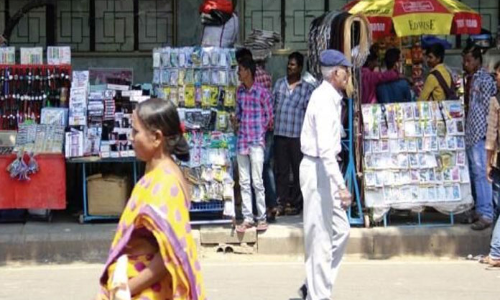Live
- Tim Southee matches Chris Gayle's six-hitting record in his farewell Test
- AP Mnister Ponguru Narayana Inspects Highway Connectivity Roads to Amaravati
- Reduced inflow: Water levels in Chembarambakkam, Poondi reservoirs drop
- Slapgate haunts CM as Rohini slams Nitish following Patna DM’s action against BPSC candidate
- Amazon Music India Unveils 'Best Of 2024’ Celebrating Top Hits, Artists & Podcasts
- Kejriwal writes to HM Shah on law and order, seeks urgent meeting
- Big e-commerce firms to adopt Safety Pledge on National Consumer Day
- Cop ends life over torture by wife, father-in-law in Bengaluru
- Indian Constitution longest and most beautiful, Kiren Rijiju lauds its inclusive character
- BSNL's Rs 333 Plan Challenges Airtel and Jio with 1300GB Data: Details
Just In

Almost all footpaths also called sidewalks, pavements on the two sides of any road, big or small, in Hyderabad, are encroached causing extreme hardship to pedestrians to walk safely, comfortably, and with dignity Footpaths and roads are twins with clear functions of movement of pedestrian traffic and motorised traffic respectively
Almost all footpaths (also called sidewalks, pavements) on the two sides of any road, big or small, in Hyderabad, are "encroached" causing extreme hardship to pedestrians to walk safely, comfortably, and with dignity. "Footpaths" and "roads" are twins with clear functions of movement of pedestrian traffic and motorised traffic respectively.
When roads are kept "clear" and road-traffic is regulated, why not the footpaths also kept clear and the pedestrian-traffic regulated? The main reason is authorities do not care for pedestrian-traffic, nor are footpaths maintained with care. It is a clear case of step-motherly treatment to the orphans - pedestrians and sidewalks.
The two unfortunate by-products of step-motherly treatment are: unclean-cluttered-encroached pavements, and (as a result) pedestrians "forced" to go on to the roads at grave risk of injury and even death. It is often said that encroachments cannot be avoided because people do not listen, they are habituated to misuse and abuse of footpaths for personal benefits, and more than anything else there is "no supervision" by GHMC and "no-control" by city traffic police Structurally, a road is in the centre, 2 pavements on 2 sides of the road, and houses/buildings beyond them.
It is the houses and buildings which "encroach" on the pavements and seriously obstruct the pedestrian-traffic. Pavements are a well-recorded public place, whereas houses and buildings (all shops included) are essentially land-based properties with "ownership", registered with government in the form of "sale-deeds".
The latter has a clear "description of properties, their measurements, boundaries, and maps-to-size". In other words, every property has "four-walls" within which alone, they can and ought to operate and under no circumstance can they either temporarily or permanently occupy/take-away/encroach public places (read pavements).
Government has to make a policy-statement and announce that property-owners must keep their construction and allied activities strictly within their four-walls , whether it is a decorative gardens, steps, trees, inclined ramps, mini-parking places, and the like. Property sale-deeds and recorded footpaths measurements are legal documents and there is no reason for any conflict/controversy.
To plan and implement the above scheme, we need the "will", and we need normal attributes of sincere, honest, and hard work by GHMC/government, cooperation of the public, and media support. The success of the fool-proof scheme invokes transparency in governance. the principle that everyone-is-equal-in-law, and sharp management skills. The issue is people-sensitive and discipline-oriented and will take time for acceptance.
It may be necessary to make a couple of pilot-runs in selected areas. The benefits of the scheme are virtually innumerable, but more so in promoting swachhata, pedestrian safety, and tourism. It will have a profound effect on automatically getting rid of the temporary hawkers and vendors who were till now the perennial targets of encroachment drives. The scope is other cities in the entire State and later the whole country.
Prof B R Sant, Hyderabad

© 2024 Hyderabad Media House Limited/The Hans India. All rights reserved. Powered by hocalwire.com







